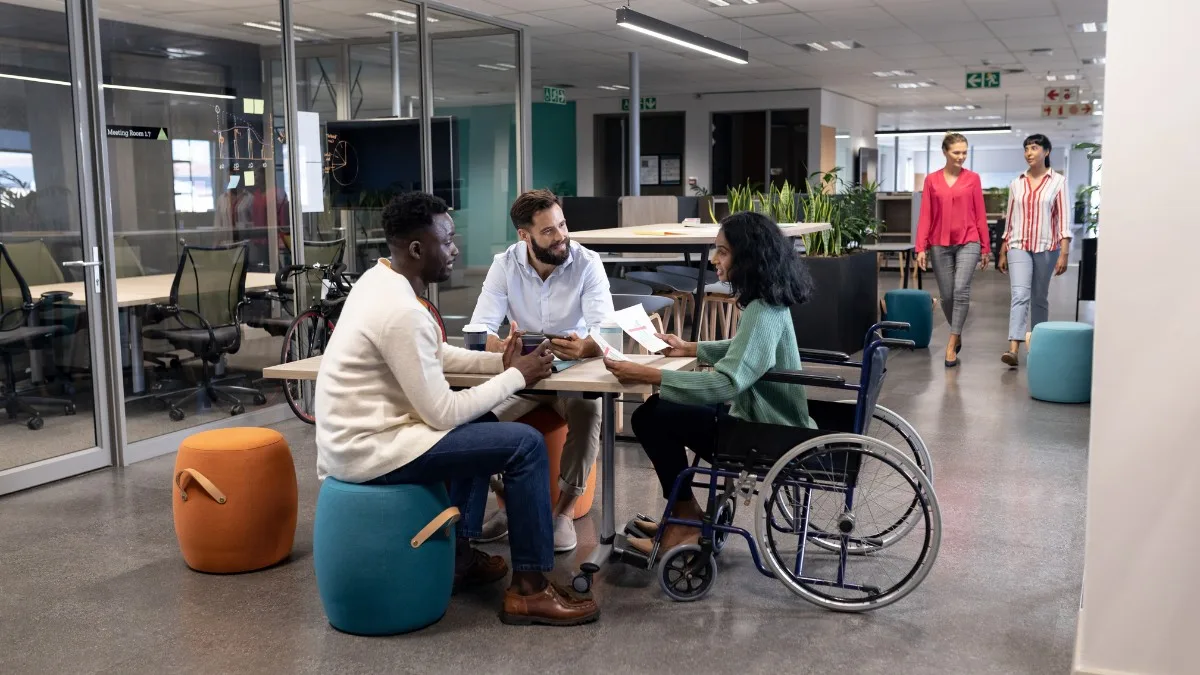October is National Disability Employment Awareness Month (NDEAM), during which we recognize the contributions of individuals with disabilities in the workforce and promote inclusive workplace practices. At Amramp, our work revolves around making the world more accessible and inclusive for everyone. Because it is at the heart of everything we do, we understand that accessibility is more than a legal obligation; it is a vital component of fostering a diverse and productive work environment. According to the U.S. Bureau of Labor Statistics (2022), the employment rate for individuals with disabilities was 19.1%, compared to 66.4% for those without disabilities, highlighting the ongoing need for more inclusive practices in the workplace.
Accessibility begins with understanding the unique needs of your workforce. The World Health Organization (2021) estimates that over 1 billion people worldwide experience some form of disability, which can significantly impact their work experience and productivity. Each employee may face different challenges, whether they are in the office, working remotely, or balancing a hybrid model. It’s essential to engage with your team to identify specific barriers they encounter, ensuring that solutions are tailored to their experiences. This approach not only promotes inclusivity but also empowers employees to take an active role in shaping a workplace that meets their needs.
Before you begin your own internal audit of accessibility within your organization, there are key variables to consider, including where your employees are based (i.e.: in-office, hybrid, remote) as well as your own internal policies. With those in mind, here are a few ways you can make your workplace more accessible.
Physical Accessibility Considerations
Office Layout and Design
- Entrances and Exits: Ensure that all entrances and exits are wheelchair accessible, with ramps and automatic doors where possible.
- Workspace Arrangement: Arrange workstations to allow for wheelchair access and ensure that pathways are clear and wide enough for mobility devices.
- Restrooms: Provide accessible restrooms equipped with grab bars and enough space for maneuverability.
Furniture and Equipment
- Adjustable Desks: Invest in adjustable desks that accommodate both standing and sitting positions, allowing employees to customize their workspace to their comfort.
- Ergonomic Chairs: Provide ergonomic seating options to support various body types and health needs.
Technology Accessibility
- Adaptive Software: Equip employees with screen readers, speech recognition tools, and other assistive technologies that cater to different needs.
- Home Office Equipment: Hybrid and remote employees should be supplied with the tools they need to perform their role at home with the same level of productivity as in an office. Consider monitors, docking stations, desks, and chairs when onboarding new employees.
- Communication Platforms: Use platforms that are compatible with accessibility tools and ensure they are user-friendly for everyone. Most platforms including Slack and Teams have accessibility features – do some research before implementing a new communication tool to ensure it checks all of your boxes.
Cognitive Accessibility Considerations
Flexible Work Arrangements
- Customized Schedules: When possible, allow employees to create flexible schedules that accommodate their individual needs, such as therapy appointments or energy levels.
- Remote Access: Ensure that all employees have access to the necessary tools and resources to work effectively from home, including IT support for technical issues.
Clear Communication
- Simple Language: Use clear, straightforward language in all communications, avoiding jargon and technical terms to minimize miscommunication.
- Visual Aids: Incorporate visual aids and diagrams in training materials to enhance understanding and retention. According to the National Center for Learning Disabilities (2022), approximately 1 in 5 individuals in the U.S. has learning and attention issues, highlighting the need for clear communication and supportive work environments.
Sensory-Friendly Spaces
- Quiet Areas: Designate quiet rooms or spaces where employees can retreat to recharge and focus without distractions.
- Adjustable Lighting: Provide options for adjustable lighting to accommodate those with sensory sensitivities, allowing employees to create their ideal work environment.
Training and Awareness Considerations
Diversity and Inclusion Training
- Workshops: Organize training sessions that educate all employees about disability awareness and the importance of inclusivity in the workplace.
- Policies and Procedures: Clearly outline your organization’s commitment to accessibility and inclusion in company policies, ensuring that all employees understand their role in creating an inclusive environment. Policies should cover employees equitably; avoid “case-by-case” statements.
Feedback Mechanisms
- Open Dialogue: Create channels for employees to voice their needs and concerns regarding accessibility. Regular check-ins can foster an inclusive culture where everyone feels valued.
- Accessibility Audits: Conduct regular assessments of your workplace’s accessibility and actively seek input from employees with disabilities to identify areas for improvement. Research from the Job Accommodation Network (2023) indicates that 70% of accommodations cost nothing, while most of the rest cost only $500 or less, demonstrating that accessibility isn’t monetarily out of reach.
Conclusion
Making the workplace more accessible is not just about compliance; it’s about embracing diversity and empowering all employees to thrive. A McKinsey report (2020) found that companies in the top quartile for gender and racial/ethnic diversity are 36% more likely to outperform their peers on profitability, reinforcing the business case for inclusive practices. By actively addressing the needs of those with physical and cognitive disabilities, employers can foster an inclusive culture that benefits everyone. As we celebrate National Disability Employment Awareness Month, let’s commit to creating environments where all individuals can contribute their unique talents and perspectives. Together, we can build workplaces that truly reflect the richness of our diverse society.
References
- U.S. Bureau of Labor Statistics. (2022). Labor Force Participation Rates by Disability Status. Retrieved from BLS.gov
- World Health Organization. (2021). World Report on Disability. Retrieved from WHO.int
- Job Accommodation Network. (2023). 2023 Workplace Accommodation Report. Retrieved from askJAN.org
- National Center for Learning Disabilities. (2022). The State of Learning Disabilities. Retrieved from ncld.org
- McKinsey & Company. (2020). Diversity Wins: How Inclusion Matters. Retrieved from McKinsey.com




